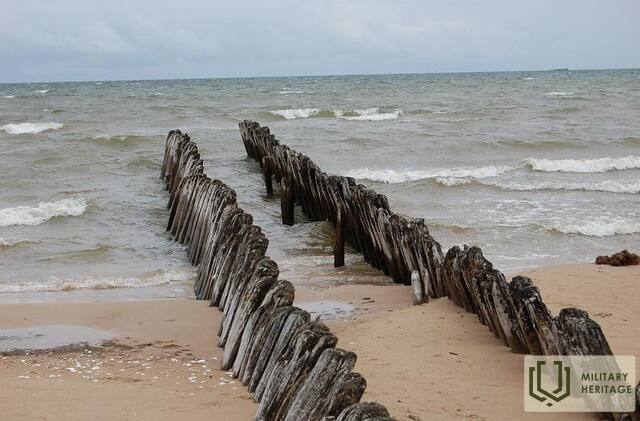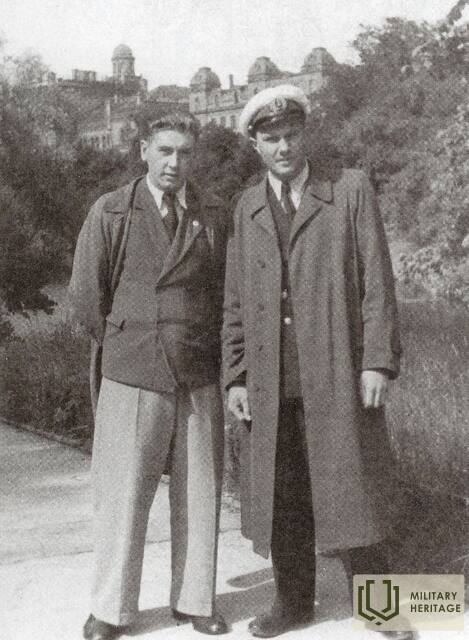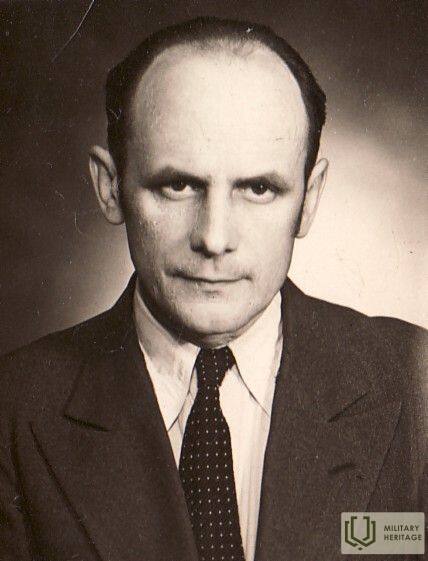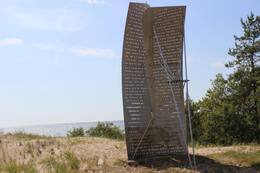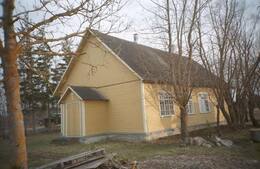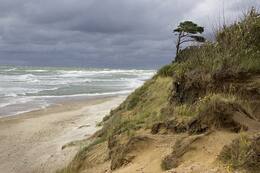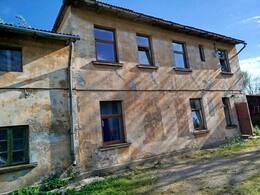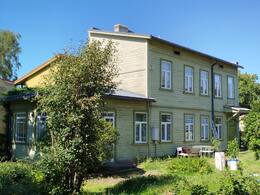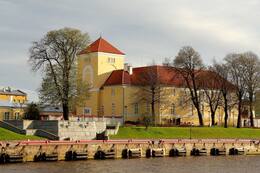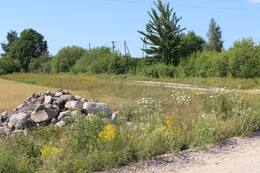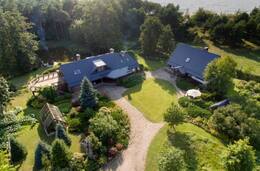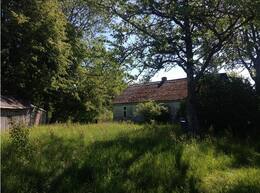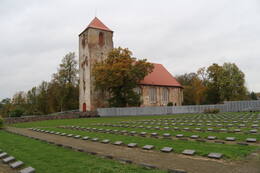Otrā pasaules kara bēgļi II WW2
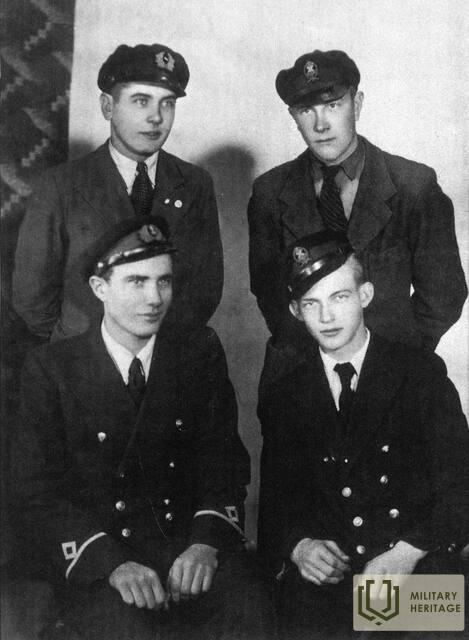
Represijas, apcietināšanas un izsūtīšanas pirmajā Padomju armijas okupācijas laikā no 1940. līdz 1941. gadam dziļi satrieca daudzus Latvijas iedzīvotājus. Tā rezultātā, kad 1944. gadā Padomju armija atkal tuvojās Latvijai un tai draudēja otrreizēja okupācija, vairāk nekā 200 000 (~ 10%) Latvijas iedzīvotāju atstāja savas mājas kara ugunīs un, riskējot dzīvību, meklēja glābiņu rietumos, Vācijas režīma kontrolētā teritorijā, jo nebija pārliecības, ka komunisti viņus neizsūtīs uz Sibīriju.
Apmēram 160 000 no tiem bija civiliedzīvotāji, lielākoties bēgļi; 30 000 bija karavīri, kas bija iesaukti Latviešu leģionā, bet 10 000 bija nosūtīti darbos uz Vāciju. Kara laikā bēgļu gaitās daudzi zaudēja dzīvību, daudzus no viņiem pārsteidza Padomju armija, tādēļ kara beigās bijušā Vācijas teritorijā palika apmēram 114 000 Latvijas iedzīvotāju.
Ne visi bēgļi nonāca Vācijā. Slepenos braucienos mazās zvejnieku laivās pāri jūrai uz Zviedriju tika pārcelti apmēram 3000 latviešu bēgļu, kam vēlāk pievienojās arī citi latvieši no Dānijas un Vācijas. Atstājot savas mājas, gandrīz visi bēgļi domāja, ka prombūtne būs īslaicīga, ka Sabiedroto armija turpinās karu, līdz kamēr visas komunistu pārņemtās zemes tiks atbrīvotas. Šīs cerības nepiepildījās, un ar laiku bēgļiem bija jāmeklē pastāvīgas mājas ārpus Eiropas.
Papildus izziņas avoti
http://pedas.lapamuzejs.lv/?page_id=1180 (skatīts 4.11.2021)
https://lv.wikipedia.org/wiki/Pirm%C4%81_pasaules_kara_latvie%C5%A1u_b%C4%93g%C4%BCi
57.0646
Saistītās laikalīnijas
Saistītie objekti
Piemiņas zīme "Cerību bura" latviešu laivu bēgļiem un to pārcēlājiem
Piemiņas zīme "Cerību bura" Otrā pasaules kara bēgļiem un to pārcēlājiem, kas 1944. un 1945. gadā ar laivām devās pāri Baltijas jūrai uz Gotlandes salu Zviedrijā. Piemineklis atrodas Ošvalkos kāpās starp jūru un Ventspils - Liepājas šoseju netālu no sabiedriskā transporta pieturas "Kaijas". Tās autors ir tēlnieks Ģirts Burvis kas to realizējis kā latviešu bēgļu piemiņu simbolizējošu cerību buru (atklāta 2000.gadā).
Laika posmā no 1944. gada rudens līdz 1945. gada pavasarim, baidīdamies no atkārtotās padomju okupācijas, bet nevēlēdamies evakuēties uz izpostīto un sarkanās armijas apdraudēto Vāciju, daļa Latvijas pilsoņu centās pa jūras ceļu nokļūt tuvākajā neitrālajā valstī - Zviedrijā. Daļu laivu ar rietumu sabiedroto valstu palīdzību organizēja Latvijas Centrālā padome, tāpēc Jūrkalnes pagastā izveidojās viena no lielākajām bēgļu koncentrācijas vietām. Bez Latvijas Centrālās padomes organizētajām laivām, pāri jūrai veda arī citi laivinieki. Tiek lēsts, ka jūru izdevās šķērsot aptuveni 5000 personām. Bojāgājušo skaits nav zināms, jo bēglu uzskaite atstājot Kurzemes krastu netika veikta.
Braucieni bija bīstami, jo bēgļus apdraudēja vācu patruļas gan krastā, gan jūrā, jūras mīnas, padomju aviācija un karakuģi, kā arī vētras, jo pārcelšanās bieži notika atklātai jūrai nepiemērotos un pārslogotos kuterīšos un laivās bez pietiekamiem degvielas un pārtikas krājumiem, jūras kartēm un navigācijas instrumentiem. Izbraukšana no Latvijas notika slepenībā. Laivu ceļamērķis bija Gotlandes sala, un braucieni visbiežāk sākās Kurzemes rietumu krastā (no Jūrkalnes līdz Gotlandes salai gaisa līnijā ir 90 jūras jūdzes jeb aptuveni 170 kilometri).
Piemineklis tiem, kuri 1944. gadā devās bēgļu gaitās pāri jūrai uz Zviedriju
Piemineklis atrodas krastmalā pie Puises zemesraga.
1944. gadā aptuveni 80 000 cilvēku devās bēgļu gaitās uz rietumiem, lai patvertos no tuvojošās Sarkanās armijas. Daudzi devās pāri jūrai. Šo pieminekli masveida bēgļu gaitu atcerei ir veidojis Aivars Simsons. Ideja par pieminekli radās Heidi Ivaskai, kura uz mātes rokām kopā ar daudziem citiem cilvēkiem gaidīja laivu Puises pludmalē. Pieminekļa veidošanu vadīja Igaunijas Atceres vietu savienība.
Pegari lūgšanu nams
Lūgšanu nams atrodas Pegarisasi ciemā netālu no Tūru-Puises ceļa 1 km atzīmes. 1944. gada 18. septembrī, dienu pēc tam, kad vācu armija sāka atkāpties, ministru prezidents Jiri Uluots kā valsts vadītājs pieņēma Igaunijas Republikas jaunās valdības amatā stāšanās zvērestu. Valdība apstiprināja rezolūciju par Igaunijas neatkarības atjaunošanu un neitralitātes saglabāšanu karā. Valdības inaugurācija nozīmēja to, ka Sarkanā armija nevis “atbrīvoja” Igauniju no vācu okupācijas spēkiem, bet gan okupēja neatkarīgu tautu. Oto Tiefa vadītais ministru kabinets pēdējo sēdi noturēja Pegari Baptistu lūgšanu namā 1944. gada 22. septembrī. Šīs vēsturiskās sēdes atcerei tur ir uzstādīta piemiņas plāksne, kuru 1999. gadā atklāja ministru prezidents Marts Lārs. Tiefa ministru kabineta locekļi lūgšanu namā gaidīja apsolīto motorlaivu, lai bēgtu uz Zviedriju. Taču laiva aizkavējās un atbrauca 29. septembrī, un tad bēgļu gaitās devās tikai valsts sekretārs Helmuts Māndi, līdzi paņemdams Igaunijas oficiālā laikraksta “Riigi Teataja” eksemplāru, kas apliecināja Igaunijas Republikas nepārtrauktību.
Mazirbes piekraste, no kurienes 1944. gadā notika bēgļu laivu satiksme uz Zviedriju
Mazirbes piekraste Otrā pasaules karā bija nozīmīga vieta, no kurienes 1944. gadā notika bēgļu laivu satiksme uz Zviedriju.
Laivu bēgles Ilonas Cīrules (dzim. Mālītis) atmiņas: “Man toreiz bija 13 gadu. Atceros, ka septemra beigās veselu nedēļu braucām karavānā no Rīgas uz Mazirbi. Brauciens palicis atmiņā kā kaut kas nepatīkams: krievu svecītes pie debesīm satrauca līdz sirds dziļumiem. Mazirbē nodzīvojām turpat trīs nedēļas, un katru dienu dzirdēju runas par braukšanu pāri un par laivu meklēšanu. Beidzot 21. oktobrī bija jātaisās. [..] Bijām kādi 90 laivā. Es sēdēju tēvam kājsarpē uz klāja. Mazie bērni ar mātēm bija lejā, un tiem tur trūka gaisa. Es laikam snauduļoju, bet otras dienas rīta pusē tika pamanīta lidmašīna un pie apvāršņa kāds kuģis. Tad gan ļaudis kļuva klusi. Pēcpusdienā atkal kuģis, un šoreiz nāk tieši mums virsū. Taču notika kā pasakā: tas bija zviedru militārais kuģis! Uzvilka mūs visus uz kuģa, dzirdīja ar siltu kakao un ieveda mūs Nineshamnas ostā. Mūsi laiviņa tika piesieta pie kuģa un tās īpašnieks Zariņš-Petravs to saņēma sveiku un veselu. Atbraucējos bija Šici, Zanderi, Vanagi, bijušā tieslietu ministra Apsīša kundze, mūsu dzimta un citi. Zinu, ka par laivu bija jāmaksā zeltā. Bet cik - to nezinu”.
Staldzenes stāvkrasts, no kura 1944. gadā notika bēgļu laivu satiksme uz Zviedriju
1944.gadā no Staldzenes stāvkrasta notika aktīva bēgļu laivu satiksme uz Zviedrijas krastiem.
Ž. Lapuķa atmiņas par tikšanos ar Dr. E. Bakūzi:
“Kādā pēcpusdienā pie manis ieradās vietējās policijas darbinieks un klusi pastāstīja, ka šai naktī aiz Staldzenes ciema pie Koku kalniem gaidāma no Zviedrijas laiva pēc bēgļiem. Mans uzdevums esot ar vienu grupu savas vienības aizsargu ierasties šīs vietas apsardzībai, un, ja vajadzīgs, palīdzēt nogādāt bēgļus līdz motorlaivai. [..] Netālu no jūras, negaidot, mūsu priekšā uz stigas nostājās kāds vīrs, pelēkā pusmēteli ar saceltu apkakli un dziļi uz pieres uzvilktu žokeja cepuri. Viņš pasaka klusu labvakar un jautā: „Šis ir ceļš uz Lošupi?" Tāda tanī vietā bija parole Zviedrijas braucējiem. Viņš saka, ka esot šeit ar speciālu uzdevumu, bet reizē vēlētos nogādāt uz Zviedriju drošībā savu ģimeni. Tad, man par lielu pārsteigumu, izvelk no kabatas mūsu virsmežniecības plānu. Krēslā sāku vērot svešinieka seju un drīz to arī pazinu. Tas bija Mežu departamenta Mežierīcības daļas vadītājs Bakūzis [..] Tuvojās pusnakts kad tālskatī jūrā saskatījām melnu punktu. Dodam ar kabatas spuldzi norunāto signālu, atkārtojot to vairākas reizes. Pēc īsa laiciņa no melnā punkta nāk tāda pati atbilde, tikai tā nav no kabatas spuldzes, bet karakuģa gaismas raidījums. Sapratām, ka šim nakti laiva vairs nav gaidāma un bēgļu bariņš sāk izklīst. Bakūzis mūs abus ar rotas komandieri uzaicināja pakavēties pie viņa ģimenes. To atradām kādā kāpu ieplakā zem kuplas egles. Tur zaļajās sūnās, uz balta spilvena nolikuši galviņas, dziļā miegā gulēja trīs šīs ģimenes atvasītes un viņiem blakus, ar baltu lakatiņu ap galvu, sēdēja rūpīgā mājas māte. Mājas tēvs sameklēja pudeli un mājas māte piedāvāja sviestmaizes. Likās, tie ar savu latvisko sirsnību ir īsti mājas tēvs un mājas māte, kuri savas mājas atraduši šai lietainā rudens nakti zem dzimtenes egles. Vienā pusē šņāc jūra, otrā mežu masīvs un caur egles zariem lēnām krīt smagas lietus lāses. Pudeli iztukšojām, bet no sviestmaizēm atsacījāmies, jo sapratām, ka tās viņiem pašiem vairāk vajadzīgas”.
Ēka Ventspilī, kur 1944. gadā dzīvoja LCP sakarniece Valentine Jaunzeme (Lasmane)
Namā Lauku ielā 4, Ventspilī dzīvoja un darbojās skolotāja Valentīne Lasmane (dzim. Jaunzeme) (1916–2018). Viņa bija LCP sakarniece un Ventspils sakaru grupas dalībniece. Pēc Otrā pasaules kara dzīvoja Zviedrijā.
130 laivu bēgļu liecības sakārtojusi izdevumā “Pāri jūrai 1944./1945.g.” (Stokholma, 1990), bet pašas V. Lasmanes dzīvesstāsts lasāms grāmatā “Nakts jau nav tikai gulēšanai” (Rīga, 2020). 2000. gadā apbalvota ar Triju Zvaigžņu ordeni. Mira 102 gadu vecumā 2018. gadā Stokholmas piepilsētā Tēbijā.
Ēka Ventspilī, kur 1944.-1945. gadā dzīvoja LCP pārstāvis un bēgļu laivu satiksmes organizators Kurzemē Dr. Valdemārs Ģinters
Nams Katrīnes ielā 4, Ventspilī, kurā darbojās arheologs Valdemārs Ģinters.
No 1944. gada oktobra līdz 1945. gada 8. maijam LCP pārstāvis Kurzemē bija arheologs Valdemārs Ģinters (segvārdi “Dakters”, “Dārznieks”) (1899–1979). Latvijas Neatkarības kara dalībnieks, Valsts vēsturiskā muzeja direktors un Latvijas Universitātes docents. Apbalvots ar Lāčplēša Kara ordeni un Triju Zvaigžņu ordeni. Viens no 1944. gada 17. marta LCP memoranda parakstītājiem. Pēc Otrā pasaules kara dzīvoja Zviedrijā. No 1949. līdz 1979. gadam Latviešu Nacionālā fonda valdes priekšsēdis.
Cietums Livonijas ordeņa pilī Otrā pasaules kara laikā
Livonijas odeņa pilī ierīkotajā cietumā 1944.-1945. gadā apcietinājumā atradās vairāki LCP Ventspils sakaru grupas dalīnieki un bēgļu laivu pārcēlāji.
Laivu pārcēlāja Žaņa Fonzova atmiņas: “Izbraucām no Zviedrijas divas laivas - “Krīvs” un “Zvejnieks”. Es biju uz “Zvejnieka”, un apkalpē bija Saulīte ar Grunti. [..] Laiks bija skaists, es braucu tā neuzkrītoši, ne sevišķi augstu. Uzreiz redzu - man morzē. Tuvojas laiva. Es lejā uz mašīntelpu, jo bez Saulītes papīriem arī man bija atbraucēju vēstules piederīgajiem Latvijā un salasītie ieroči maisā. Sabāzu vēstules un papīrus tanī ieroču maisā un visu pāri bortam.. Kā tad! Laiva klāt pie mūsējās un vācieši prasa mūsu braukšanas atļaujas. [..] Tā nu 21. oktobrī vācieši veda mūs ar visu “Zvejnieku” uz Ventspili. Noveda mūs uz cietumu. Tur telpā kādi 30 cilvēki. Man bija mugurā tāds aitādas kažociņš, liku to uz grīdas un pats virsū, taču pagājušā nakts bja negulēta. Otrā trešā dienā sauc mūs laukā pratināt. Bijām norunājuši teikt, ka esam bēgļi ceļā uz Vāciju. Es tikai biju gribējis aizbraukt uz Lielirbi savai brūtītei pakaļ. Liekas, šie mums noticēja toreiz. [..] Bet, tad Ventspilī mainījās stāvoklis: pilsētu pārņēma militārā pārvalde, un mūs izsauca uz pratināšanu otrreiz. Nu bija sliktāk, jo rādīja mums zviedru sērkociņu kastīti un vienu kronas gabalu, kas esot atrasti uz laivas. Viens no pārklaušinātājiem bija latvietis, un tas net mums ar galvu, lai stāstot visu patiesību. Redzējām, ka pasaciņai beigas, vienkārši bija jāatzīstas”.
Ceļš uz "Grīnieku" mājām Vārves pagastā
Ceļš uz “Grīnieku” mājām Vārves pagastā, kur 1944. gadā atradās viena no galvenajām laivu bēgļu apmešanās vietām Kurzemes piekrastē.
Laivu pārcēlāja V. Jurjaka atmiņas: “Ieejot “Grīnieku” pagalma, viss izskatījas ļoti normāli. Klusa lauku māja, neviena dvēsele, laikam cilvēki diendusā. [..] Izrādījās, ka ne tikai “Grīnieku” dzīvojamā māja bija pilna ar cilvēkiem, bet pilnas bija visas būves. Kūtsaugša, klēts, siena šķūnis un pirtiņa. Satiku vienu otru paziņu, jo bija pienācis laiks mūsu zemi atstāt. [..] Uztura stāvoklis nebija kritisks, bet diezgan trūcīgs. [..] Vakarā sāka bēgļu karavāna virzīties uz jūrmalu. Iepriekš brīdināju visus nenākt laukā no krūmiem pie jūrmalas, jo netālu atradās krasta sargu zemnīcas un novērošanas punkti. Tā bija liela karavāna, jo uz jūrmalu devās visi apmēram vairāk par 200 cilvēku. Nebija cerības, ka visi tiks laikā. Vakars nebija visai tumšs, un es varēju pārskatīt visas grupas darbības norisi. Visuzkrītošākās bija lielās mantu kaudzes. Cilvēkiem dzīvojot “Grīniekos”, tās neredzēja, bet tagad, kad tās izcēla gaismā, tikai to redzēja. Mantām vien vajadzēja veselu laivu. 3-4 divu zirgu redeļu rati bija piekrauti ar mantām, kuriem sekoja cilvēki. [..] Laivu gaidījām ilgi, bet tā nepienāca. Visai karavānai bija jāatgriežas. Bija stipri tumšs”.
Bēgļu pagaidu mitekļi "Vārves būdas"
"Vārves būdas”, vieta Ventspils novadā, kas kalpoja par pagaidu mitekli latviešu bēgļiem, kas 1944. gadā gaidīja pienākam laivas no Gotlandes.
Laivu pārcēlāja V. Jurjaka atmiņas:
“Pie mums bija ieradies no Rīgas mans pusbrālis ar ģimeni un, kad pienāca ziņa, ka gaidāma laiva pie Vārves, es apvienoju šos savus ļaudis ar policijas priekšnieka Jasūnasa grupu un visi izbraucām uz Vārvi. Gaidījām signālus līdz vēlai naktij, bet laiva nepienāca. Tā mēs gaidījām tur veselu nedēļu. Sāka līņāt. Ļaudis no palagiem sacēla tādas teltis, tāpēc šo vietu nosaucām par “Vārves būdām”. Mēs ar sievu pa dienu bijām vairāk pa Ventspili, un ar laiku bija jādomā, kā piegādāt gaidītājiem pārtiku. Atceros, kādu nakti mēs ar sievu uz divriteņiem vedām pa mežu viņiem karsti novārītus kartupeļus. Lija stiprs lietus, zibeņoja un rūca, un siltie kartupeļi labi garšoja izlijušajiem gaidītājiem. Šo slēpšanās vietu nejauši bija atklājis Vārves mežsargs, bet - apsolot viņam arī pārvešanas iespēju, viņš nāca palīgā. Vācieši bija sākuši staigāt pa jūrmalnieku mājām, meklējot pēc cilvēkiem iesaukšanas gados. Netālu no “Vārves būdām” mežā bija noķerti divi jauni cilvēki. Tālab šī vieta nevarēja vairs būt droša šiem pāri par pussimts cilvēkiem, kas te nīka”.
"Bambaļu" mājas - viena no galvenajām laivu bēgļu apmešanās vietām
Atjaunotās “Bambaļu” mājas Ošvalkos, Jūrkalnes pagastā, kas 1944. gadā bija viena no galvenajām laivu bēgļu apmešanās vietām Kurzemes piekrastē.
Laivu bēgļa Kārļa Draviņa atmiņas: “”Bambaļi” bija vecas, mazas, stipri nolaistas mājas Jūrkalnes pagastā, apmēram 40 kilometrus no Ventspils. [..] Apkārt pletās nelieli lauciņi mitrajā vietā, bet turpat otrā pusē apvijās apkārt veca, apaugusi kāpa. Gabaliņu aiz tās šalca jūra - mājas bija pavisam klāt pie jūras. Otrā pusē, puskilometra attālumā, gāja Pāvilostas-Užavas dižceļš, taču gatve līdz mājām nebija viegli izbraucama, kāpēc vācieši nevarēja būt ikdienišķi viesi šeit. Viegli bija piesniedzama laivu sagaidīšanas vieta - kāds meža lodziņš augstā krastā. [..]
”Bambaļu” saimniece ar savu grupu, kas arī gaidīja uz “ūdens kustēšanos”, dzīvoja divās istabās uz jūras pusi, bet bēgļu pulciņš mitinājās otrā mājas galā, arī divās istabās. Virtuvi izmantoja kopīgi. Priekšnamiņu starp abiem galiem piebāza ar bēgļu daudzajām mantām. Istabās guļa bija salmos, kas bija izlikti visgarām gar sienām. Katrā pusē istabā bija viena gulta, kur gulēja kāda māte ar bērniem. Salmu guļas pa dienu apklāja ar palagiem vai ko citu. Tanīs iznāca sēdēt vai gulēt arī dienā, jo citur nebija, kur palikt. [..] Dienas gāja vienmuļi, viena kā otra. Cēlās pavēlu, nebija, kur steigties. Kad kopgalda brokastis bija paēstas, vieni gāja spēlēt kārtis, daži noņēmās ar zīlēšanu, bet citi mēģināja lasīt. Kādiem bija jāiet saimniecības darbos - jāgādā malka, ūdens”.
"Laukgaļu" mājas, rakstnieka Kārļa Skalbes apmešanās vieta
“Laukgaļi” Jūrkalnes pagastā, rakstnieka Kārļa Skalbes apmešanās vieta 1944. gada oktobrī - novembrī, gaidot bēgļu laivu uz Zviedriju.
Rakstnieks Kārlis Skalbe (1879–1945) bija Latviešu Pagaidu Nacionālās padomes un Latvijas Tautas padomes loceklis, Latvijas Republikas Satversmes sapulces un 1. un 4. Saeimas deputāts. Vācu okupācijas laikā – literārā žurnāla “Latvju Mēnešraksts” galvenais redaktors, viens no 1944. gada 17. marta LCP memoranda parakstītājiem.
1944. gada 11. novembrī devās bēgļu gaitās uz Zviedriju. Mira 1945. gadā Stokholmā.
Pāvilostas novadpētniecības muzeja pastāvīgā ekspozīcija
Muzeja patstāvīgā ekspozīcija stāsta par Pāvilostas pilsētas vēsturi un par bēgļi gaitām Otrā pasaules kara laikā un pēc tā, padomju laikiem piekrastē, dzintaru ķeršanu pludmalē, kā arī ar svarīgākajiem notikumiem 100 gadu griezumā Pāvilostā. Apmeklētājiem iespēja iejusties zvejnieku lomā un ar 3D brillēm piedalīties reņģu un nēģu zvejā.
Blakus muzejam atrodas Laivu māja, kurā apskatāmi lielgabarīta eksponāti. Savulaik ēkā glabājusies laiva, ar kuru glābšanas dienesta komanda devusies jūrā glābt nelaimē nokļuvušos zvejniekus un jūrniekus.
Ekspozīcija “PĀVILOSTA - SLĒGTĀ ZONA” stāsta par Pāvilostu padomju okupācijas gados, par šādām tēmām: izpildvara, pierobežas zona, zvejnieku kolhozs, kultūras dzīve un sadzīve. Izveidota arī interaktīva emocionāli bagāta digitāla ekspozīcija divās valodās un audio - vizuālā instalācija.
Digitālā ekspozīcijā var redzēt senus notikumus un to, kā ir veidojusies Pāvilosta un visas aktivitātes no 1918. gada līdz šim laikam, t.sk. Neatkarības karu, PSRS un vācu okupāciju, bēgļu kustību Otrā pasaules kara laikā
Lestenes Brāļu kapi
Atrodas Tukuma novadā, Lestenē, līdzās baznīcai.
Brāļu kapu izveide Lestenē aizsākās 1998. gadā. Tā ir otra lielākā karavīru kapsēta Latvijā, kur vienkopus apglabāti vairāk nekā 1300 latviešu leģionāri. Tikai pēc Latvijas Republikas atjaunošanas bija iespēja no dažādām vietām pārapbedīt 2. pasaules karā kritušos latviešu karavīrus.
Latviešu leģions bija Vācijas armijas kaujas vienība, kas formēta galvenokārt no pretlikumīgi mobilizētiem Latvijas iedzīvotājiem. Karavīri savu atrašanos leģionā uztvēra kā cīņu par Latvijas neatkarības atjaunošanu, neraugoties uz to, ka tā notika Vācijas bruņoto spēku rindās un Vācija bija okupējusi Latviju. Cita militāra spēka, kas varētu aizkavēt padomju okupācijas atgriešanos, nebija. Latviešu leģionāri cīnījās pret Sarkano armiju, kura bija likvidējusi Latvijas neatkarību, iznīcinājusi tās armiju un veikusi noziegumus pret civiliedzīvotājiem. Vācijas armijas rindās cīnījās ap 110 000–115 000 karavīru, apmēram 30 000–50 000 no viņiem savas dzīvības atstāja kauju laukos.
Mūsdienās Lestenē var aplūkot Brāļu kapus, kam līdzās atrodas Lestenes baznīca. Tā ir izcils baroka sakrālās mākslas piemērs. Senajā baznīcas krogā var iepazīties ar Latviešu leģiona vēsturei veltītu ekspozīciju. Brāļu kapu centrālo tēlu "Dzimtene - Māte - Latvija" veidojusi tēlniece Arta Dumpe. Netālu atrodas Lestenes muiža, kas pirms 2. pasaules kara piederēja Latvijas armijas ģenerālim Mārtiņam Hartmanim.
Ekskursijas Lestenes baznīcā var pieteikt pie Lestenes evanģēliski luteriskās baznīcas draudzes priekšnieces Ingunas Kokinas, tālrunis +371 29993743.
Saistītie stāsti
Valentīnes Lasmanes veiksmīgā bēgšana
Valentīnes Lasmanes uzrakstīts biogrāfisks stāsts par to, kā viņai izdevās izbēgt no apcietinājuma vācu okupācijas laikā
Pēdējās Kārļa Skalbes dzimšanas dienas svinības Kurzemes piekrastē
1944. gada 7. novembrī gaišu noskaņu latviešu bēgļu apmetnē Kurzemes piekrasē ienesa dzejnieka Kārļa Skalbes 65. dzimšanas dienas atceres Jūrkalnes “Laukgaļos”. Tikai četras dienas vēlāk Kārlis Skalbe devās ar laivu uz Zviedriju bēgļu gaitās. Tā bija diena, kad Kārlis Skalbe pēdējo reizi svinēja savu dzimšanas dienu.
Valdemāra Ģintera slepenā un bīstamā darbība
Valdemāra Ģintera vārds bija daudzu latviešu bēgļu pēdējā cerība aizbēgt pāri uz Zviedriju. Pārāk lielā bēgļu uzmanība bija bīstama un tādēļ Ģinters ieturēja slepenību
Bēgļu laivu pārcelšanās vieta no Kurzemes piekrastes uz Zviedriju pie "Pāžu" mājām
Viena no būtiska pārcelšanās vieta bija pie “Pāžu” mājām, kur tagad ir uzstādīts piemineklis - “Cerību bura”. "Kuģīši nāca regulāri un no “Pāžiem” aizbrauca visvairāk cilvēku”", vēsta I.Freiberga atmiņas.




